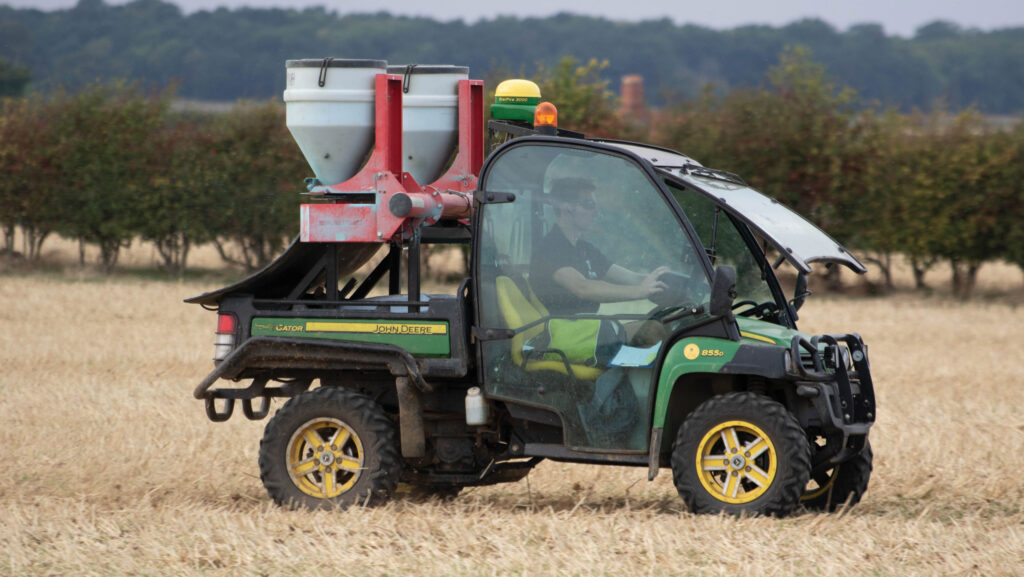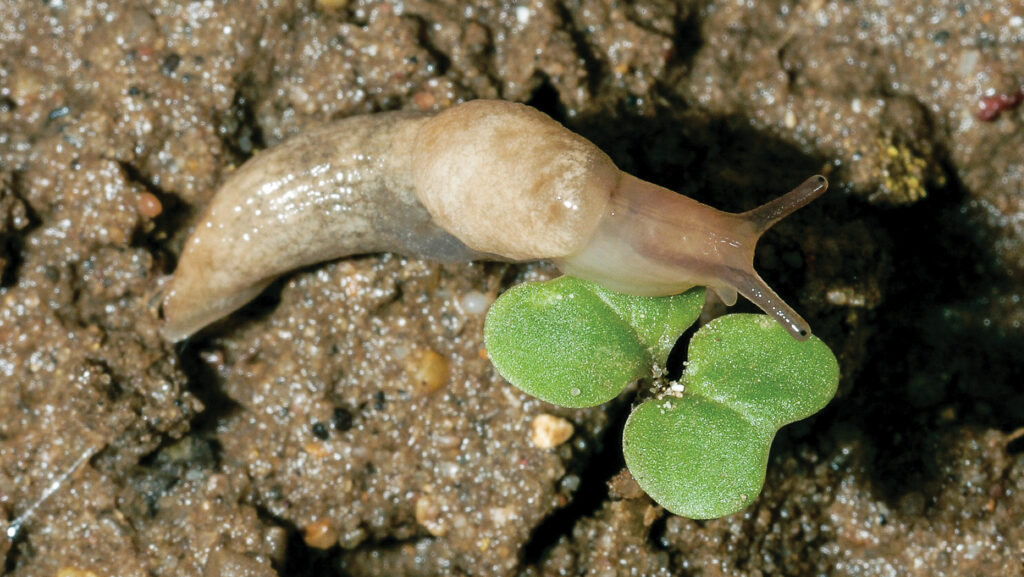Why slug pressure is intensifying and what farmers can do
 © Tim Scrivener
© Tim Scrivener A changing climate and evolving farming systems could lead to more frequent slug population explosions, and growers must be alert and ready to react.
It is widely accepted that UK winters are getting milder and wetter, and if any arable cropping year illustrates it, this is it.
The mild and wet winter landscape created ideal conditions for slugs, which were part of a mix of issues that conspired to create patchy or thin crops and cause some complete failures.
See also: Notts Monitor Farm sees benefits of reduced cultivations
Keith Walters, Harper Adams University professor of invertebrate biology and integrated pest management, is a key player in an Innovate UK-funded research project on slugs in cropping systems.
One of the project’s aims is to better understand slug population dynamics, and work has proven that slugs congregate in distinct stable patches driven by soil characteristics and the slug’s behaviour.
Important lessons
Prof Walters says that the extreme wet and high slug pressure last winter threw up some important lessons.
An accepted theory is that when soils become too wet, slugs within these patches effectively drown and populations take a hit leading into the spring.
“However, we’ve found that they change their behaviour again in these conditions and the patch behaviour is effectively over-ridden by an instinct to move to less wet areas to survive,” he explains.
This means that although slug populations were knocked back slightly by the wettest period of the winter, as any waterlogging receded, they began to reform their patches.
Then, aided by a lack of frosts and continued showers for much of spring and into summer, considerable slug populations built up into July.
While the data isn’t there to identify slug pressure trends over seasons, Keith says growers are entering unchartered territory in the extremity and frequency of such weather events and what their impact might be on populations in the medium term.
“They are clearly resilient to wet conditions and the fluctuations in pressure could become more pronounced. We may start seeing some trends soon,” he adds.
In the short term, he stresses the importance of monitoring slug activity through this harvest, as populations are likely to be high and will threaten establishment of several crops, oilseed rape in particular.
“It is also important to keep an eye on the weather and if pellet applications are necessary, growers should move quickly and not get caught out again, as some were last year.”

© Blackthorn Arable
Systems change
Farming systems are also changing, with a trend to moving less soil and the introduction of cover crops and Sustainable Farming Incentive (SFI) options.
Keith says this could potentially make slug pressure worse, but it is not as simple as saying the risk will be higher everywhere.
He explains that more year-round ground cover will shield slugs from danger and create damp conditions at the soil surface for them to breed.
However, some plant species are more palatable to slugs than others, so they may not always have a suitable food source, unless certain weeds thrive within the cover crop or SFI areas.
These areas may also encourage natural predation by invertebrates like beetles, which will suppress populations to differing levels.
“These measures are necessary to protect soils, and the SFI framework is sound, but as growers try different things, we may find they affect certain pests or disease more than others, including slugs.
“We need to keep a close eye out for the unexpected.”
Vigilance required
This is a sentiment shared by Ceres Rural agronomist Jock Willmott, who is seeing unusually high slug numbers in cereal crops in his region which will present problems in early-drilled oilseed rape.
Populations are also increasing on farms that are integrating cover crops into their systems, particularly where brassicas are included.
As an example, he witnessed much greater pressure in spring barley drilled after covers this year, even where all green material was completely destroyed a month ahead of drilling.
With less soil being moved generally, much greater vigilance is required when establishing crops, particularly this year.
Farms with 2023 SFI agreements can rotate some options, such as pollen and nectar mix (ALH2) and legume fallow (NUM3), and these could increase slug risk in following crops, Jock says.
“It will depend on when options are destroyed and the cultivation regime that is in place, but vigilance will be required there as well.
“Some farms will save cost and drill straight into those situations if they can, but if soil conditions aren’t good enough or the drill can’t cope, then some cultivation will be required, [with] the added benefit of reducing slugs,” says Jock.
Good seed-beds
In general, there is likely to be more cultivation after this harvest to rectify surface compaction caused by the heavy winter rain.
Some soils may not dry out sufficiently to support harvest traffic without suffering structural damage, which again will push growers into moving soil to achieve optimal seed-beds.
“You must drill into the right conditions and get good seed-to-soil contact, as it’s seed hollowing that’s the biggest issue with slugs.
“You can manage grazing with repeat applications of pellets, if necessary, but once the seed has gone there’s no going back,” he adds.
For Association of Independent Crop Consultants (AICC) agronomist Tod Hunnisett, who advises growers in Sussex, cultivations are king for managing slugs in high-pressure situations and he is concerned about the reliance on slug pellets in some systems.
He says timing of cultivation is important, with the aim to burst eggs and expose the pest to predation.
“The recent thinking about moving the top two-to-three inches in oilseed rape stubbles straight after harvest to hit flea beetle larvae should apply to slugs, too. It will help to reduce numbers.”
Tod adds that greater emphasis should be placed on risk assessment to target cultivations and monitoring efforts.
“Crops after oilseed rape are most at risk, followed by second cereals. Any situation after a winter crop, where soil hasn’t been undisturbed for some time, may also need monitoring and managing accordingly.”
Testing conditions
Ferric phosphate pellets were pushed to the limit by last year’s wet conditions and high pest pressure, prompting Certis Belchim technical manager James Cheesman to stress that the vehicle used to deliver the active is critical.
Where growers could get on with pellets in autumn and winter, he says cheaper ones degraded much faster than pasta-based wet processed Sluxx HP pellets, which proved more durable.
The product also contains an EDDS chelating agent – the substance that gets a lethal dose of ferric phosphate into the slug’s gut – instead of the more common EDTA. This keeps the pellets efficacious for longer in the wet.
“Formulation is often overlooked in many areas of crop protection. If you have a pellet that’s more durable and remains active for longer, it’s going to give growers an edge in the tough conditions we experienced last year,” says James.
Pellet size
Given the pressure heading into oilseed rape drilling this month he adds that pellet size choice is another consideration.
A mini pellet product like Menorexx – which has an identical formulation to the standard sized Sluxx HP – will give a higher number of baiting points when the crop is most vulnerable.
“Just be mindful that as weather and soils get wetter, the larger pellet will be more durable simply because of its size.
“Whichever pellet you choose, make sure your applicator is calibrated correctly and you know the limitations of both the pellet and spreader. You can find that information by using our online calibration wizard tool,” he concludes.
